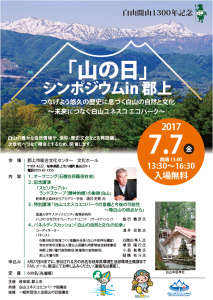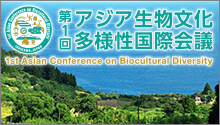Sorry, this entry is only available in 日本語.
Hakusan:アーカイブ
白山ユネスコエコパーク協議会の参与メンバーとなりました
2015年05月12日
OUIK Biocultural Diversity Series #4 [Learning About the Satoyama and Satoumi of Hokuriku Region from Maps]
2018年07月10日
Map information compiled by various scales to learn about the link between anthropogenic activities and physical environment within Hokuriku Region.
SDGs Dialogue #5: International symposium “Exploring the Concept of Green Infrastructure in Urban Landscapes: Applications and Collaboration in Kanazawa”
2018年09月29日
An international symposium exploring the concept of green infrastructure in urban landscapes was held in Kanazawa, which in 2018 marked 50 years since its Ordinance on the Preservation of the Traditional Environment (Currently Ordinance on urban planning with beautiful landscape in Kanazawa) entered into force. Green infrastructure refers to land use planning that aims to achieve sustainable development by reassessing nature from a multifunctionality perspective. Because of this ordinance, the vegetated slopes, canals, riverfronts, temples, traditional gardens and other unique elements integrated with the city’s landscape and scenery have been conserved and restored. This symposium invited experts from various fields in and outside Japan to participate in a discourse on whether Kanazawa’s urban landscape could be redefined as green infrastructure.
In Part 1, titled “Understanding Green Infrastructure”, examples of green infrastructure around the world were introduced. Various viewpoints were presented — for example, that utilizing existing canals, parking lots, and other infrastructure is an important part of building livable cities, and that green infrastructure should be defined by each region.
In Part 2, research and initiatives related to green infrastructure, mainly in Kanazawa, were presented on the symposium’s theme. In a report from the perspectives of disaster risk reduction, the environment, and economy, the unique potential of green infrastructure in Kanazawa was discussed, with unusual benefits connected to crime deterrence and education being described. In a presentation on the need for sustainable conservation efforts and collaborative management, it was proposed that sustainable conservation could be realized in conjunction with Goals 11, 15, and 17 of the SDGs.
Part 3 was held as a roundtable in which attendees discussed the use of urban landscapes as green infrastructure. Lots of views were expressed, including comparisons between green and gray infrastructure, the advantages of substituting the words “nature protection/conservation” with green infrastructure, and that visualizing the multifunctional benefits of green infrastructure is critical to deepening our understanding of it.
As ideas were shared, we at OUIK felt that this symposium was a tangible first step in disseminating from Kanazawa a theoretical framework on urban planning and green infrastructure that will allow communities worldwide to advance sustainable development in a unified way.
Report on the International Workshop Shiramine 2018: ‘University Education for Mountain UNESCO Eco-Parks Created with Diverse Stakeholders
2018年04月02日
2018/4/2, Hakusan
Report on the International Workshop Shiramine 2018: “University Education for Mountain UNESCO Eco-Parks Created with Diverse Stakeholders”
Date: March 31, 2018 (Saturday) 14:00 – 16:30
Location: “Yohei” – a traditional farmhouse built in the Edo period (NPO Shiramine Nature School)
Co-Organizers:
- United Nations University Institute for the Advanced Study of Sustainability, Ishikawa-Kanazawa Operating Unit (UNU-IAS OUIK)
- NPO Shiramine Nature School
- Hakusan UNESCO Eco-Park Council
- Kanazawa University International Institute
Cooperation: Ishikawa Prefectural Hakusan Nature Conservation Center
The International Workshop Shiramine 2018 was held with a total of 24 participants, featuring Scottish mountain researcher Martin Price (who visited Japan from March to April 2018 as a Short-Term Foreign Research Fellow from the Japan Society for the Promotion of Science, hosted by the Tsukuba University Mountain Science Center).
14:00-14:10 Introduction (Venue Explanation)
At the beginning of the workshop, the coordinator, Yoshihiko Iida from the UNU-IAS OUIK, provided an introduction to the workshop’s purpose. He raised the question of how to develop human resources activities (especially university education), which is one of the three functions of UNESCO Eco Parks, in collaboration with various stakeholders. Following this, Mr. Takashi Yamaguchi from the co-hosting organization, the Shiramine Nature School, introduced the venue, “Yohei,” a traditional house built in the Edo period, along with the activities of the nature school.
14:10-14:50 Mini Lecture: “Introduction to Scotland’s UNESCO Eco-Parks and Activities of the University of the Highlands and Islands”
Martin Price (Professor at the University of the Highlands and Islands) presented examples of Scotland’s UNESCO Eco-Parks, including the Galloway and Southern Ayrshire UNESCO Biosphere, which supports branding for livestock and fishery products using local logos, and the Wester Ross UNESCO Biosphere, designated for its integrated mountain and coastal landscapes.
Additionally, there was an introduction to the University of the Highlands and Islands, which is a unique institution in the UK. It operates as a partnership of 13 institutions, including nine vocational training colleges and three specialist training schools in fisheries, Celtic culture, and theology, as well as a marine science research center. The university primarily conducts online distance education programs, with most students coming from Scotland, including many working professionals aged 30 and over. Research is also being conducted focusing on the Wester Ross UNESCO Biosphere. From 2017 to 2020, with support from the EU, a project promoting sustainable ecotourism was implemented in collaboration with sites in Scotland, Norway, Finland, Iceland, and Greenland.
14:50 – 15:50: Case Presentations
To provide insights from the Hakusan Tedorigawa UNESCO Global Geopark, Ms. Erika Takasaki (Secretary of the Hakusan Tedorigawa UNESCO Global Geopark Council) introduced its characteristics, history of registration, and operational structure, as well as network activities with UNESCO Eco-Parks and affiliated entities domestically and internationally.
Next, Mr. Norimasa Toga, presented on the initiatives of the Ishikawa Prefectural Hakusan Nature Conservation Center, explaining the overview of alpine zone monitoring conducted as part of the Ministry of the Environment’s Monitoring Site 1000. He also highlighted wildlife monitoring activities conducted at the Bunao Mountain Observation Building since 1981, as well as volunteer collaboration efforts for invasive plant removal and monitoring changes since 2004. Mr. Koji Ogawa then shared the long-term monitoring activities of the snowfield at Senjagaike on the summit of Mount Hakusan, ongoing since 1981, showcasing changes over the years.
Ms. Aida Mamadova (Kanazawa University International Institute) introduced Kanazawa University’s regional learning initiatives conducted at the International Center since 2015, discussing the significance of education from the perspective of biocultural diversity and the outcomes of student education in a camp format within local communities. She noted that while international students show significant interest, Japanese students tend to show less engagement, presenting this as a challenge. Additionally, the status of four UNESCO Eco-Parks in Russia was introduced, along with future plans for student exchange programs with Russia.
15:50 – 16:30: Discussion
In the discussion session, participants aimed to deepen interaction. Representatives from the Ministry of the Environment’s Hakusan Conservation Office, NPO Kan Hakusan Protection and Management Association, Tsukuba University Mountain Degree Program, Kanazawa University Noto Campus (Noto Satoyama Satoumi Meister Training Program), Mie University Future Earth program, Hakusan Tedori River Geopark Promotion Council, and Aeon Environmental Foundation shared brief overviews of their activities and comments related to university education, the theme of the workshop.
Participants expressed that university education plays a significant role as an entry point for understanding nature conservation efforts and local realities, along with expectations for universities as research institutions. The presence of university representatives from Tsukuba, Kanazawa, and Mie universities underscored the importance of grassroots connections between universities across regions.
Finally, Mr. Hiromasa Yamashita (Secretary General of the Hakusan Tedorigawa UNESCO Global Geopark / Secretary General of the Hakusan Tedori River Geopark Promotion Council) delivered closing remarks as a co-organizer.
We would like to extend special thanks to Mr. Daniel Heliot (Coordinator for International Relations, City of Hakusan) for his exceptional assistance with interpreting for Martin Price throughout the event.
Report by: Yoshihiko Iida (Research Associate, UNU-IAS OUIK / Advisor to the Hakusan UNESCO Eco-Park Council)
The Seventh East Asian Biosphere Reserve Network (EABRN) Training Workshop
2017年09月26日
Dr. Yoshihiko Iida participated in the 7th training workshop of the East Asian Biosphere Reserve Network (EABRN) (cover photo provided by MAB National Committee of the Republic of Korea).
A workshop titled ‘Biodiversity Infomatics in Big Data Era’ was held in Institute of Botany, Chinese Academy of Sciences (IBCAS) from September 4 (Mon.) to 9 (Sat.), 2017. 47 participants from 17 Asian countries (Uzbekistan (1), Tajikistan (2), Kazakhstan (2), Mongolia (2), Pakistan (3), India (1), Bangladesh (1), Sri Lanka (1), Philippines (3), Thailand (2), Vietnam (3), Nepal (2), Malaysia (1), Indonesia (1), South Korea (6), China (15), and Japan (1)) participated in the workshop.
The training course started with a lecture from Prof. Keping Ma (the Institute of Botany, Chinese Academy of Science) on the importance of information sharing on biodiversity conservation and monitoring particularly based on the field of taxonomy at Asian scale. More than 10 researchers from the institute provided lectures of more specific information on the topic. Through these lectures, participants learnt various methodologies to build specimen database utilizing the internet and to monitor animals and plants in forest areas with IT and remote sensing techniques. In addition, participants visited a long-term forest ecosystem monitoring site to understand and learn from the practical methods in the field. On September 9 (Sat.), Mr. Qunli Han, the former director of the Division of Ecological and Earth Sciences of UNESCO, gave a lecture on various efforts related to UNESCO Biosphere Reserves at global scale.
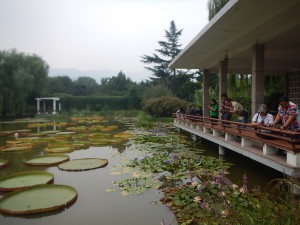
Botanical garden at Institute of Botany
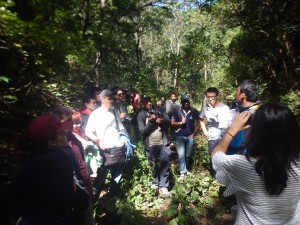
Introduction of research activities at the long-term forest ecosystem monitoring site in Beijing (Donglingshan 20-ha forest dynamic plot)
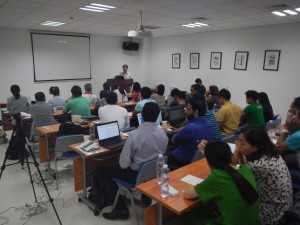
Lecture on UNESCO Biosphere Reserves from Mr. Qunli Han

Greeting from Prof. Keping Ma to participants
The second half of the 7th EABRN workshop was held in South Korea from September 11 (Mon.) to 14 (Thu.), 2017. Seven people from four countries (Russia (2), Kazakhstan (2), Mongolia (2), and Japan (1)) participated and visited Gwangneung Forest Biosphere Reserve (GFBR) and Mount Sorak Biosphere Reserve (MSBR) in the northern part of the country (hosted by: MAB National Committee of the Republic of Korea and UNESCO Beijing Office). In the GFBR, together with local citizens, participants learnt about the current condition and measures against pine wilt disease and oak wilt disease in the forest reserve. In the MSBR, after listening to the explanation on the outline of the National Park’s governance and visiting a visitor center and a National Herbarium, the participants understood their various activities on wildlife (such as insects and mammals) protection, conservation, and monitoring in practice. They also visited related field sites. The efforts of protecting and conserving Korean goral species (closely related to serow) in the MSBR (implemented by Species Restoration Technology Institute, Korea National Park Services) were well explained. During the discussion, Dr. Iida pointed out about a case of wildlife damage in Japan similar to problems occurring in South Korea. It was recognized that wildlife management was a common issue for both countries. Furthermore, the activity of “Citizen College” at MSBR was introduced as the best practice that has contributed to connect the citizens with the Biosphere Reserve, through its course and alumni network.

Insect monitoring site in a forest plot (photo: MAB National Committee of the Republic of Korea)
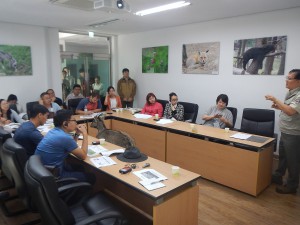
Explanation about the goral conservation activities being carried out by Species Restoration Technology Institute, Korea National Park Services, in Mount Sorak Biosphere Reserve
This international workshop and attendance of the participants were fully supported by UNESCO Beijing Office.
Learning through a Global Network and Conservation of Biological and Cultural Diversity – Insights from the UNESCO Biosphere Reserve Cases'”
2016年05月20日
2016/5/11
On May 11, 2016 (Wednesday), a publication commemorating the Biological and Cultural Diversity Series #2 titled “Hakusan Biosphere Reserve– A Community Future Woven by People and Nature” was held as an event.
Noëline Raondry Rakotoarisoa from UNESCO Headquarters (Paris, France), Chief of the MAB Networking Section of the Ecological and Earth Sciences Division, visited the United Nations University Institute for the Advanced Study of Sustainability (Shibuya, Tokyo) and spoke at the international symposium titled “Learning through a Global Network and Conservation of Biological and Cultural Diversity – Insights from the UNESCO Eco-Park Cases.”

Left: Kazuhiko Takemoto, Director of the IAS; Center: Noëline Raondry Rakotoarisoa; Right: Tsuneo Watanabe, Director of IAS-OUIK

During the event, she exchanged views with practitioners from eight UNESCO Biosphere Reserves across Japan on how Japan can contribute to learning with the world.
At the symposium, Yoshihiko Iida, a researcher from OUIK, presented on “Approaches for Learning with the Global Network – Goals of the United Nations University OUIK Booklet ‘Hakusan UNESCO Biosphere Reserve’.”
Additionally, Shinsuke Nakamura (a member of the Japan UNESCO Biosphere Reserve Network Operating Working Group and Secretariat of Hakusan Biosphere Reserve Council) provided insights on “Connecting with Global UNESCO Biosphere Reserves – Contributions from the 4th World Congress of Biosphere Reserves”
The cooperative efforts of the United Nations University OUIK and local stakeholders in the UNESCO Biosphere Reserves were shared as case studies.
During her first visit to Japan, Ms. Raondry Rakotoarisoa commented that the experiences of Japan’s UNESCO Biosphere Reserves provide valuable lessons for the global network.
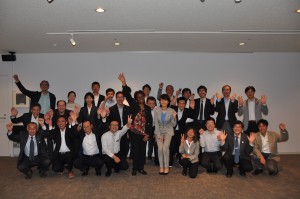
(Author: Yoshihiko Iida)
Special Lecture by Dr. Iida at Mountain Day Symposium Marking 1300th Anniversary of Mount Hakusan in Gujo City
2017年07月18日
Invited presentation at the 10th Southeast Asia Biosphere Reserves Network Meeting
2017年05月23日
Dr. Yoshihiko Iida, OUIK research associate, participated in the 10th Southeast Asia Biosphere Reserves Network (SeaBRnet) meeting to make key note speech “Roles and challenges of local implementation for UNESCO science program: A case of Japanese BRs”
He contributed by introducing biosphere reserves in Japan as well as jointly implemented project by OUIK and Mount Hakusan BR “Mutual Learning Platform for Asian Local Practitioners of UNESCO’s Man and the Biosphere (MAB) Programme” in 2016 .
He also chaired the session on the coordination of UNESCO science programs including Geopark, International Hydrological Programme (IHP) and World heritage. Detailed report can be refereed from UNESCO Jakarta and Japanese Funds-in-Trust (JFIT)
16-17 May 2017 (Dr. Iida participated session on 16th)
Indonesia, Jakarta
Event Report ー Noëline Raondry Rakotoarisoa, UNESCO Headquarters MAB Networking Officer, Invited to Hakusan UNESCO Biosphere Reserve
2017年07月18日
The Hakusan UNESCO Biosphere Reserve was registered in 1980 as the first UNESCO Biosphere Reserve in Japan, along with three other parks. In March 2016, it received approval for an extension of its transitional area.
OUIK, based in Ishikawa Prefecture, has been collaborating with the Hakusan UNESCO Biosphere Reserve Council since 2014. To discuss the management and operations following the extension registration, we invited Noëline Raondry Rakotoarisoa, the Chief of the MAB Networking Section at UNESCO Headquarters in Paris, France.
Duration: May 6 (Friday) to May 10 (Tuesday), 2016 (May 11-12 at the United Nations University headquarters in Tokyo)
Location: Within the Hakusan UNESCO Biosphere Reserve area
From May 7 (Saturday) to May 10 (Tuesday), Ms. Rakotoarisoa visited all municipalities in the four prefectures and seven cities and villages that make up the Hakusan UNESCO Biosphere Reserve, including Nanto City in Toyama, Shirakawa Village and Takayama City in Gifu, Gujo City, Ono City, and Katsuyama City in Fukui, and Hakusan City in Ishikawa. She deepened her understanding of the region’s nature, culture, and history through direct dialogues with local stakeholders.
On May 10 (Tuesday), we co-hosted the “Symposium Commemorating the Extension Registration of Hakusan UNESCO Biosphere Reserve,” during which Ms. Rakotoarisoa and the mayors of the constituent cities and villages exchanged opinions on how to advance UNESCO Biosphere Reserve activities (ecosystem conservation and sustainable regional development) in the Hakusan region.
(Reported by Yoshihiko Iida)
OUIK Biocultural series booklet #2 [Mount Hakusan Biosphere Reserve] is now available
2016年05月30日
OUIK Biocultural series booklet #2 [Mount Hakusan Biosphere Reserve -Creating a new path for communities and nature-] is now available from our publication archive. (view PDF) This booklet has been produced by collaboration with 7 local municipals of Hakusan UNESCO Biosphere Reserve as well as UNESCO MAB networking team to celebrate the acceptance of revision plan with newly set transition zone.
We are looking forward to see how learning opportunity will be developed by communities with this booklet .


